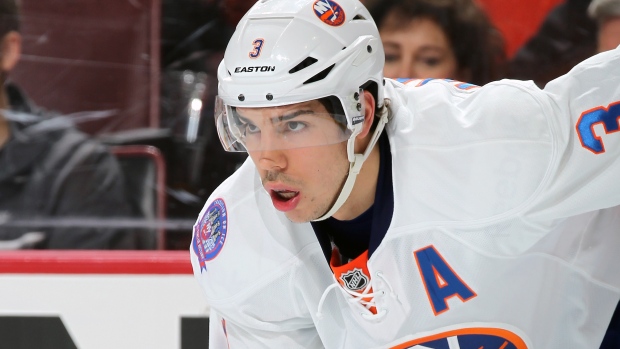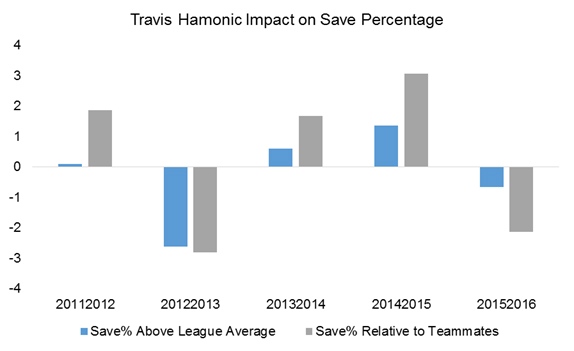Sep 15, 2016
Defencemen and their impact on team save percentage
Travis Hamonic of the New York Islanders has been a regular defender in the NHL for years now. Are we confident that he has a positive or negative impact on his goaltenders’ save percentage? As Travis Yost writes, there is zero statistical evidence that a player can truly impact his team’s save percentage over long periods of time.
By Travis Yost

One of the more debatable theories the hockey analytics community has championed over the last few years is that individual defencemen don’t appear to have an impact on their team’s save percentage.
The argument behind the theory is straightforward: A player’s on-ice or team-relative save percentage varies greatly from year to year. Because there’s such volatility and unpredictability, it’s impossible to draw a connection between a player’s given on-ice or team-relative save percentage and a genuine talent.
Why is this important? Well, let’s talk about goal-scoring rates for a moment. When we have an outlay of historical goal-scoring data for a given forward, we can make reasonably accurate predictions about where said forward’s goal-scoring rates will go in future periods. Why? Because goal-scoring is a repeatable skill, and, generally speaking, your better goal-scorers will remain better goal-scorers while your weaker goal-scorers will remain weaker goal-scorers.
A defender’s impact on save percentage is essentially the opposite. tUsing historical impact on save percentage to forecasthe future is no better than flipping a coin – repeatability year-to-year is essentially zero.
This doesn’t necessarily make intuitive sense – we think of defenders as having innate talents of deterring shooters and playing angles, some better than others, and would be inclined to believe that they could positively (or negatively) impact their goaltender year after year. Perhaps an example can tell this story better than I can.
Travis Hamonic of the New York Islanders has been a regular defender in the NHL for years now, and we are confident that he’s top-four talent. Are we confident that he has a positive or negative impact on his goaltenders’ save percentage? Well, that seems to depend on which year you’re asking the question.

In 2011-12, Hamonic looked like he impacted his goaltender in a favourable manner. The Islanders’ goaltending was dreadful that year, but actually slightly above average with Hamonic on the ice. And when compared to his teammates, Hamonic looked like a superstar!
But then 2012-2013 hit, and Hamonic appeared to have a dreadful impact on his team’s save percentage. His goalie performed well below average when he was on the ice, and Hamonic’s teammates had a much more positive impact than he did that season. So, in just one season, our theory changed from “Hamonic does well here!” to “Hamonic is pretty bad here!”
You can see where I’m going with this. The two seasons after the lockout-shortened year, Hamonic’s impact on his goaltenders again turned positive. But, before we had time to pivot on our theory of what Hamonic was (or wasn’t) on the defensive side of the ice, his numbers took a 180 during the 2015-16 season.
So, yes, five years and hundreds of games later, we don’t really know what Hamonic’s impact is on goaltender performance. This is also true for most every defender in the league – their numbers swing emphatically from good to bad and back to good before you can blink an eye.
Much of the effort on determining whether or not a defender has an impact on save percentage focuses on year-to-year repeatability. One thing I was curious about was whether any available metric could reasonably forecast a player’s impact on save percentage in the subsequent year.
The answer to that question is an emphatic no.
So, what’s the conclusion? For now, there is simply zero evidence that a player can truly impact his team’s save percentage over long periods of time. It flies in the face of what some may instinctively think (myself included, many moons ago), but the counterargument just has no supporting statistical evidence. (The lone caveat here: in the event that additional data becomes readily available, perhaps by player tracking technology, there may be an ability to uncover some real supporting evidence.)
If you’re a front-office executive, one of the things you can do in the meantime is continue to bet on regression. Whether that means targeting players victimized randomly by poor save percentages over certain intervals or moving players out who luckily benefited from their own goaltender’s save-percentage bender, there’s a real opportunity to win on the trade block.

